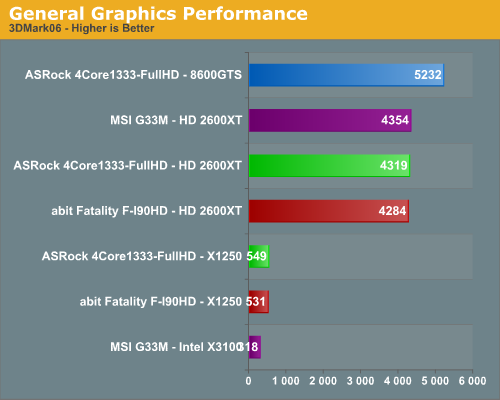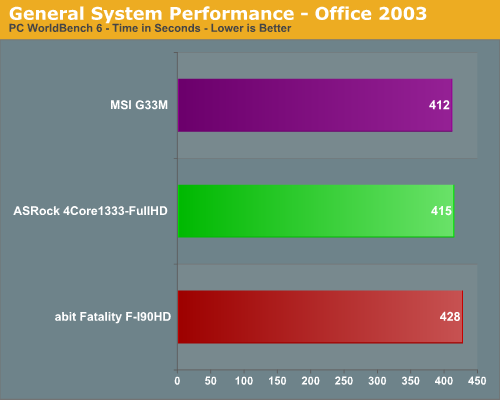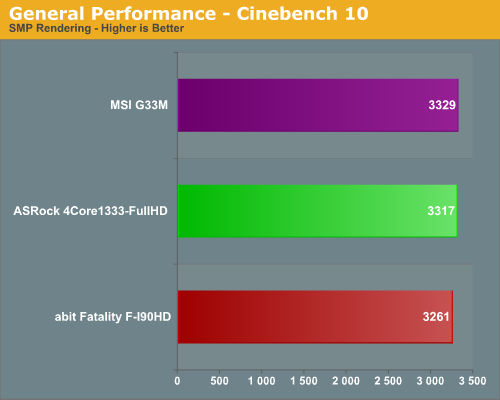µATX Part 1: ATI Radeon Xpress 1250 Performance Review
by Gary Key on August 28, 2007 7:00 AM EST- Posted in
- Motherboards
Synthetic Graphics Performance
The 3DMark series of benchmarks developed and provided by Futuremark are among the most widely used tools for benchmark reporting and comparisons. Although the benchmarks are very useful for providing apples-to-apples comparisons across a broad array of GPU and CPU configurations they are not a substitute for actual application and gaming benchmarks. In this sense we consider the 3DMark benchmarks to be purely synthetic in nature but still very valuable for providing consistent measurements of performance.

In our first test, the G33 makes for a great showing against the X1250 offerings. So we are being a bit sarcastic in that announcement as we consider these results to be anything but great considering it is the later part of 2007. The G33 platform like our X1250 platforms could not complete the Shader Mark 3.0 tests since it is not supported on this chipset. The X1250 did exceed the G33 in the CPU tests. In fact, the CPU test is where the X1250 shined in this test, almost to the point of making us wonder if this test really has any relevance at this point.
General System Performance
The PCMark05 benchmark developed and provided by Futuremark was designed for determining overall system performance for the typical home computing user. This tool provides both system and component level benchmarking results utilizing subsets of real world applications or programs. This benchmark is useful for providing comparative results across a broad array of Graphics subsystems, CPU, Hard Disk, and Memory configurations along with multithreading results. In this sense we consider the PCMark benchmark to be both synthetic and real world in nature while providing consistency in our benchmark results.

The margins are very close in the PCMark05 results with the G33 platform showing a minor advantage over the X1250 platforms due to better storage system performance results. While this benchmark is designed around actual application usage, we will see if these results mirror our application testing.
The Office 2003 test from the PC WorldBench 6.0 benchmark test suite features a number of test scripts that simulate general office tasks in Access, PowerPoint, Excel, and Word.

These tests consistently favored the Intel G33 chipset due to improved memory bandwidth and slightly lower latencies which are important in this series of applications. The ASRock board scores about 4% better than the abit board and this pattern will continue throughout our testing regimen.
Rendering Performance
We are using the Cinebench 10 benchmark as it tends to heavily stress the CPU subsystem while performing graphics modeling and rendering. Cinebench 10 features two different benchmarks with one test utilizing a single core and the second test showcasing the power of multiple cores in rendering the benchmark image. We utilize the standard multiple core benchmark demo and default settings.

We see the Intel G33 chipset basically out-muscling the AMD X1250 equipped abit board with a minimal improvement over the ASRock board. This test indicates the strength of the ASRock implementation of the X1250 in the fact that the X1250 can certainly stand toe to toe with the G33, at least against the business oriented implementation from MSI.
The 3DMark series of benchmarks developed and provided by Futuremark are among the most widely used tools for benchmark reporting and comparisons. Although the benchmarks are very useful for providing apples-to-apples comparisons across a broad array of GPU and CPU configurations they are not a substitute for actual application and gaming benchmarks. In this sense we consider the 3DMark benchmarks to be purely synthetic in nature but still very valuable for providing consistent measurements of performance.

In our first test, the G33 makes for a great showing against the X1250 offerings. So we are being a bit sarcastic in that announcement as we consider these results to be anything but great considering it is the later part of 2007. The G33 platform like our X1250 platforms could not complete the Shader Mark 3.0 tests since it is not supported on this chipset. The X1250 did exceed the G33 in the CPU tests. In fact, the CPU test is where the X1250 shined in this test, almost to the point of making us wonder if this test really has any relevance at this point.
General System Performance
The PCMark05 benchmark developed and provided by Futuremark was designed for determining overall system performance for the typical home computing user. This tool provides both system and component level benchmarking results utilizing subsets of real world applications or programs. This benchmark is useful for providing comparative results across a broad array of Graphics subsystems, CPU, Hard Disk, and Memory configurations along with multithreading results. In this sense we consider the PCMark benchmark to be both synthetic and real world in nature while providing consistency in our benchmark results.

The margins are very close in the PCMark05 results with the G33 platform showing a minor advantage over the X1250 platforms due to better storage system performance results. While this benchmark is designed around actual application usage, we will see if these results mirror our application testing.
The Office 2003 test from the PC WorldBench 6.0 benchmark test suite features a number of test scripts that simulate general office tasks in Access, PowerPoint, Excel, and Word.

These tests consistently favored the Intel G33 chipset due to improved memory bandwidth and slightly lower latencies which are important in this series of applications. The ASRock board scores about 4% better than the abit board and this pattern will continue throughout our testing regimen.
Rendering Performance
We are using the Cinebench 10 benchmark as it tends to heavily stress the CPU subsystem while performing graphics modeling and rendering. Cinebench 10 features two different benchmarks with one test utilizing a single core and the second test showcasing the power of multiple cores in rendering the benchmark image. We utilize the standard multiple core benchmark demo and default settings.

We see the Intel G33 chipset basically out-muscling the AMD X1250 equipped abit board with a minimal improvement over the ASRock board. This test indicates the strength of the ASRock implementation of the X1250 in the fact that the X1250 can certainly stand toe to toe with the G33, at least against the business oriented implementation from MSI.










22 Comments
View All Comments
Brick88 - Thursday, August 30, 2007 - link
doesn't anyone feel that AMD is cutting itself short? Yes Intel is their primary competitor but by not producing an igp chipset for intel based processors, they are cutting themselves out of a big market. Intel ships the majority of processors and AMD will need every single stream of revenue to compete with Intel.bunga28 - Wednesday, August 29, 2007 - link
Charles Dickens would roll over his grave if he saw you comparing these 2 boards by paraphrasing his work.Myrandex - Tuesday, August 28, 2007 - link
I don't knwo why they would ever put that name on the board. the fact that it is getting beat by a ASRock motherboard in gaming performance is pathetic, since that name is supposed to be all about gaming (no offense to the ASRockers out there, as they aren't bad boards I have more experience with them then fatal1ty's anyways).Etern205 - Tuesday, August 28, 2007 - link
On the "abit Fatality F-I90HD: Feature Set" page,that Abit EQ software interface of a car looks
familar one of those real models.
Like this one
<img>http://img404.imageshack.us/img404/8490/toyotafjhh...">http://img404.imageshack.us/img404/8490/toyotafjhh...
source:
http://www.automobilemag.com/new_car_previews/2006...">http://www.automobilemag.com/new_car_previews/2006...
strikeback03 - Tuesday, August 28, 2007 - link
I was thinking Hummer, either way...Etern205 - Tuesday, August 28, 2007 - link
Not really because the face of a Hummer is differentthan the one from Toyota. The face of a Hummer has
vertical grill bars, while the Toyota does not.
strikeback03 - Wednesday, August 29, 2007 - link
However the Hummer has the full-width chrome fascia, the Toyota has a part-width sorta satin chrome thing.I highly doubt they licensed an image of either, so it can't look exactly like any vehicle. I remember a lawsuit between Jeep and Hummer over the 7 vertical slots in eachother's grilles several years ago.
eBauer - Tuesday, August 28, 2007 - link
Why are the Xpress 1250 systems running tighter timings (4-4-4-12) where the G33 system is running looser timings (5-5-5-12)?strikeback03 - Tuesday, August 28, 2007 - link
Top of page 8
Mazen - Tuesday, August 28, 2007 - link
I have a 6000+ (gift) and I am just wondering whether I should go with a 690G or wait for nvidia's upcoming MCP 78. Can't wait for the 690G review... thoughts anyone?